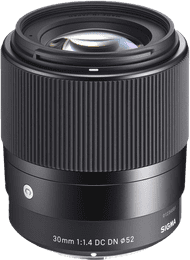A great bright lens, unfortunately without stabilization
- Very sharp
- Bright
- Solid housing
- No image stabilization
Herman G.
18 August 2017
Automatically translated from Nederlands
According to our camera lens expert
The Sigma E 30mm f/1.4 is a wide-angle lens for Sony mirrorless cameras. It has a large maximum aperture of f/1.4. You can create a depth of field effect and take qualitative photos in poor light situations. Thanks to the 9 aperture shutters that make the opening of the aperture round, you get a nice bokeh effect in your photos. Thanks to the light and compact design, you can easily take the lens with you when you travel to capture the most beautiful landscapes or buildings. The silent autofocus motor makes the lens suitable for videography and capturing your object silently. The lens has also been optimized to prevent aberrations and distortions.
Lens mount | Sony E mount | |
Suitable for camera type | APS-C | |
Zoom or prime lens | Prime lens | |
Fixed focal point | ||
Lens type | Wide-angle | |
Image stabilization | ||
Weight | 263 g | |
Type of photography | Landscape |
5 stars
26
4 stars
5
3 stars
1
2 stars
0
1 star
0
10 () | |
10 () | |
10 () | |
10 () |
Herman G.
18 August 2017
Automatically translated from Nederlands
Niels R.
16 August 2016
Automatically translated from Nederlands
Steije Hillewaert
18 March 2018
Automatically translated from Nederlands
Bradley Oosterveen
4 October 2017
Automatically translated from Nederlands
Mertens Frans
6 February 2017
Automatically translated from Nederlands
Marijn Beekwilder
6 April 2018
Automatically translated from Nederlands
daan Verstrepen
19 March 2018
Automatically translated from Nederlands
Sanne
30 April 2019
Automatically translated from Nederlands
Stephan Pronin
8 January 2019
Automatically translated from Nederlands
Jeffry De Meyer
26 April 2019
Automatically translated from Nederlands
Herman G.
18 August 2017
Automatically translated from Nederlands
Niels R.
16 August 2016
Automatically translated from Nederlands
Steije Hillewaert
18 March 2018
Automatically translated from Nederlands
Receive more coverage in case of damage than with your standard warranty. Coolblue takes care of everything: from taking out the insurance to repairs. Is a repair not possible? You receive the purchase price as CoolblueCredit.
XCover is allowed to arrange and process insurances on behalf of the insurer. The insurances are governed by Belgium law. If you have a complaint, you can contact the or our customer service.
First, add your camera lens to your shopping cart. On the next page, choose one of the Protection Plans below. You always have a 30-day return window and pay no deductible in case of damage or theft.
The insurance can be canceled every year, even if you have paid in advance. If you cancel earlier, you will receive a refund for the overpaid amount.

When you buy the Sigma E 30mm f/1.4 DC DN C Sony, you receive 1 extra year of warranty from Sigma for free. You can register your promotional product for the Sigma promotion up to 8 weeks after the date of your purchase. Go to the promotional Terms and Conditions (PDF) for more information.

Current product

APS-C
APS-C
APS-C
APS-C, Full frame
APS-C
No
No
Yes
No
Yes
263 g
405 g
181 g
281 g
154 g
Landscape
Architecture and interior, Landscape
Architecture and interior, Landscape
Landscape, Nature photography, Portrait, Product
Landscape, Nature photography, Portrait, Product
Product number | 705068 | |
Manufacturer code | 07660.302965 | |
Brand | Sigma | |
Warranty | 2 years | |
Processing of your defect | Via Coolblue |
Lens type | Wide-angle | |
Type of photography | Landscape |
Lens mount | Sony E mount | |
Suitable for camera type | APS-C | |
Compatible with lens filter | ||
Filter size | 52 mm | |
Lens series | Contemporary |
Zoom or prime lens | Prime lens | |
Maximum magnification factor | 0,14 | |
Number of aperture shutters | 9 | |
Number of groups | 7 | |
Number of elements | 9 | |
Special lens elements | ||
Image stabilization | ||
Fixed focal point |
Shortest focusing distance | 30 cm | |
Manual focus override | ||
Silent focusing motor | ||
Type of focusing motor | Stepping Motor | |
Internal focus | ||
Focal distance control | ||
Autofocus |
Color | Black | |
Weight | 263 g | |
Material | Plastic | |
Diameter | 64,8 mm | |
Length camera lens | 73,3 mm |
Dustproof | ||
Shockproof |